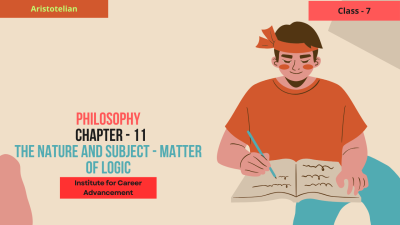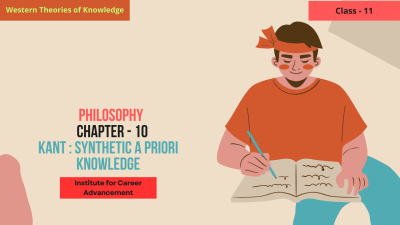Courses


 Compare
Compare
Logic is the study of reasoning and argumentation. It's concerned with how we think, how we construct arguments, and how we can determine whether those arguments are valid or sound. Key Aspects: Formal vs. Informal Logic: Formal Logic: Deals with the structure and form of arguments, focusing on the validity of inferences based on their logical form, regardless of the content. Informal Logic: Concerned with the content and context of arguments, evaluating them for their strength, relevance, and persuasiveness in everyday language. Core Concepts: Propositions: Statements that can be either true or false. Arguments: A set of propositions where one or more (premises) are intended to support another (conclusion). Validity: A deductive argument is valid if its conclusion necessarily follows from its premises. Soundness: A deductive argument is sound if it is both valid and its premises are true. Laws of Thought: Law of Identity: A thing is identical to itself (A is A). Law of Non-Contradiction: A thing cannot be both A and not-A at the same time and in the same respect. Law of Excluded Middle: A thing must either be A or not-A; there is no third option. যুক্তি হল যুক্তি এবং যুক্তির অধ্যয়ন। আমরা কীভাবে চিন্তা করি, কীভাবে যুক্তি তৈরি করি এবং সেই যুক্তিগুলি বৈধ বা সঠিক কিনা তা আমরা কীভাবে নির্ধারণ করতে পারি তার সাথে এটি সম্পর্কিত। মূল দিকগুলিঃ আনুষ্ঠানিক বনাম। অনানুষ্ঠানিক যুক্তিঃ আনুষ্ঠানিক যুক্তিঃ বিষয়বস্তু নির্বিশেষে, তাদের যৌক্তিক রূপের উপর ভিত্তি করে অনুমানের বৈধতার উপর দৃষ্টি নিবদ্ধ করে আর্গুমেন্টের কাঠামো এবং ফর্মের সাথে ডিল করে। অনানুষ্ঠানিক যুক্তিঃ তর্কের বিষয়বস্তু এবং প্রসঙ্গের সাথে সম্পর্কিত, দৈনন্দিন ভাষায় তাদের শক্তি, প্রাসঙ্গিকতা এবং প্ররোচনার জন্য তাদের মূল্যায়ন করা। মূল ধারণাগুলিঃ প্রস্তাবনাঃ এমন বিবৃতি যা সত্য বা মিথ্যা হতে পারে। যুক্তিঃ প্রস্তাবের একটি সেট যেখানে এক বা একাধিক (প্রাঙ্গণ) অন্য (উপসংহার) সমর্থন করার উদ্দেশ্যে করা হয় বৈধতাঃ একটি অবরোহী যুক্তি বৈধ যদি তার উপসংহার অবশ্যই তার প্রাঙ্গণ থেকে অনুসরণ করে। দৃঢ়তা (সাউন্ডনেস): একটি অনুমানমূলক যুক্তি যদি বৈধ হয় এবং এর ভিত্তি উভয়ই সত্য হয়। চিন্তার নিয়মঃ পরিচয়ের আইনঃ একটি জিনিস নিজের সাথে অভিন্ন (এ হল এ) অ-দ্বন্দ্বের আইনঃ একটি জিনিস একই সময়ে এবং একই ক্ষেত্রে এ এবং না-এ উভয়ই হতে পারে না। বাদ দেওয়া মধ্যের আইনঃ একটি জিনিস অবশ্যই A বা না-A হতে হবে; কোনও তৃতীয় বিকল্প নেই।
0 Lessons
Hours

 Compare
Compare
Natural vegetation refers to the plant life that grows naturally in a particular region without human interference. It is influenced by factors like climate, soil, and topography. Types of Natural Vegetation: Forests: Dense growth of trees. Tropical Evergreen Forests: Found in regions with heavy rainfall, characterized by tall trees with diverse flora and fauna. Tropical Deciduous Forests: Found in areas with seasonal rainfall, trees shed their leaves during the dry season. Temperate Evergreen Forests: Found in areas with moderate rainfall, dominated by coniferous trees. Temperate Deciduous Forests: Found in areas with four distinct seasons, trees shed their leaves in autumn. Grasslands: Areas dominated by grasses. Tropical Grasslands (Savannas): Found in tropical regions with distinct wet and dry seasons. Temperate Grasslands (Prairies): Found in temperate regions with moderate rainfall. Deserts: Areas with sparse vegetation due to low rainfall. Tundra: Found in cold regions, characterized by low-lying shrubs and mosses. Wildlife: Wildlife refers to all the animals, birds, insects, and other organisms that live naturally in a particular region. It includes a wide variety of species, from tiny insects to large mammals. Relationship between Natural Vegetation and Wildlife: Natural vegetation provides food, shelter, and habitat for wildlife. In turn, wildlife plays a crucial role in seed dispersal, pollination, and maintaining the ecological balance. Conservation of Natural Vegetation and Wildlife: National Parks and Wildlife Sanctuaries: Protected areas where wildlife is conserved. Afforestation and Reforestation: Planting trees to restore degraded forests. Sustainable Use of Natural Resources: Using natural resources wisely to minimize environmental impact. Awareness and Education: Creating awareness about the importance of conserving natural vegetation and wildlife. প্রাকৃতিক গাছপালা বলতে সেই উদ্ভিদ জীবনকে বোঝায় যা মানুষের হস্তক্ষেপ ছাড়াই একটি নির্দিষ্ট অঞ্চলে প্রাকৃতিকভাবে বৃদ্ধি পায়। এটি জলবায়ু, মাটি এবং ভূসংস্থানের মতো বিষয়গুলির দ্বারা প্রভাবিত হয়। প্রাকৃতিক উদ্ভিদের প্রকারঃ বনঃ গাছের ঘন বৃদ্ধি। ক্রান্তীয় চিরহরিৎ বনঃ বিভিন্ন উদ্ভিদ ও প্রাণীজগৎ সহ লম্বা গাছ দ্বারা চিহ্নিত ভারী বৃষ্টিপাতের অঞ্চলে পাওয়া যায়। ক্রান্তীয় পর্ণমোচী বনঃ মৌসুমী বৃষ্টিপাতের অঞ্চলে পাওয়া যায়, শুষ্ক মরসুমে গাছগুলি তাদের পাতা ঝরিয়ে দেয়। নাতিশীতোষ্ণ চিরহরিৎ বনঃ শঙ্কু গাছ দ্বারা প্রভাবিত মাঝারি বৃষ্টিপাতযুক্ত অঞ্চলে পাওয়া যায়। নাতিশীতোষ্ণ পর্ণমোচী বনঃ চারটি স্বতন্ত্র ঋতু সহ অঞ্চলে পাওয়া যায়, গাছগুলি শরত্কালে তাদের পাতা ফেলে দেয়। তৃণভূমিঃ ঘাস দ্বারা প্রভাবিত অঞ্চল। ক্রান্তীয় তৃণভূমি (সাভানা) ক্রান্তীয় অঞ্চলে স্বতন্ত্র আর্দ্র এবং শুষ্ক ঋতু সহ পাওয়া যায়। নাতিশীতোষ্ণ তৃণভূমি (প্রেইরি) নাতিশীতোষ্ণ অঞ্চলে পাওয়া যায় যেখানে মাঝারি বৃষ্টিপাত হয়। মরুভূমিঃ কম বৃষ্টিপাতের কারণে বিরল গাছপালা সহ অঞ্চল। তুন্দ্রাঃ শীতল অঞ্চলে পাওয়া যায়, নিচু ঝোপঝাড় এবং শসা দ্বারা চিহ্নিত। বন্যপ্রাণীঃ বন্যপ্রাণী বলতে একটি নির্দিষ্ট অঞ্চলে প্রাকৃতিকভাবে বসবাসকারী সমস্ত প্রাণী, পাখি, পোকামাকড় এবং অন্যান্য জীবকে বোঝায়। এর মধ্যে রয়েছে ক্ষুদ্র পোকামাকড় থেকে শুরু করে বড় স্তন্যপায়ী প্রাণী পর্যন্ত বিভিন্ন প্রজাতির প্রজাতি। প্রাকৃতিক উদ্ভিদ ও বন্যপ্রাণীর মধ্যে সম্পর্কঃ প্রাকৃতিক গাছপালা বন্যপ্রাণীর জন্য খাদ্য, আশ্রয় এবং আবাসস্থল সরবরাহ করে। ফলস্বরূপ, বন্যপ্রাণী বীজ বিতরণ, পরাগায়ন এবং পরিবেশগত ভারসাম্য বজায় রাখতে গুরুত্বপূর্ণ ভূমিকা পালন করে। প্রাকৃতিক উদ্ভিদ ও বন্যপ্রাণী সংরক্ষণঃ জাতীয় উদ্যান ও বন্যপ্রাণী অভয়ারণ্যঃ সংরক্ষিত এলাকা যেখানে বন্যপ্রাণী সংরক্ষণ করা হয়। বনায়ন ও বনায়নঃ অবক্ষয়প্রাপ্ত বন পুনরুদ্ধারের জন্য গাছ লাগানো। প্রাকৃতিক সম্পদের টেকসই ব্যবহারঃ প্রাকৃতিক সম্পদকে বিজ্ঞতার সঙ্গে ব্যবহার করে পরিবেশগত প্রভাব কমিয়ে আনা। সচেতনতা ও শিক্ষাঃ প্রাকৃতিক উদ্ভিদ ও বন্যপ্রাণী সংরক্ষণের গুরুত্ব সম্পর্কে সচেতনতা সৃষ্টি করা।
1 Lessons
Hours

 Compare
Compare
Ramkumarni latha(রামকুমারনি লাথা)kothoma swinai wngkha swikwrwng snahamoy roy choudhury (স্নেহময় রায় চৌধুরী).O kothomani bisingtwi Ramkumar mungui khoroksani nukhungni kokno sajak kha bahai khe Ram kumarni langmao jora hamya o kwlaiui bebak no kwmaui thangbai tei bo sakbaithangbo mokol nukjaya bini bihik bo sak hamya kwlai mani bisik tham bisik brwi wngkha hai phano bo bwkha baiyaui bwsajla kusu kalungno tuiui samung khaijao . Bihikno Bithi birai pai chari jao ham nani wansukgwi phiya ba a jorao Ram kumarni bwsjla kusu Kalung salsa lumma baino buma bupphani maya no I hayungno yakwrwi thangkha tepsa khe Ram kumar bwkha hamya nangjago bini lama sonai, bini logi rinai , bini langmani latha no kwmaui thangma haiu wngjago.
1 Lessons
Hours

 Compare
Compare
Para kaklaima(পারা কাকলায়মা) kokbom swinai wngkha swikwrwng Sudhanwa Debbarma.O kokbom Hachwk khurio kothomayungni Gangacharan bai Mangal sordar walaima kok tisaui phunuk jak kha.Swkango khe borog para kaisa tongo tei mwtai atai rilai khebo para kaisa khalaio abo haino kami ker mwtai khlai khe bo thansa kheno khlai laio phiyaba tabuk khe borog khetni ari ni bagwi kokbanglaimani para kaklaikha tei swkangni hai ker bo thansa khwlailai liya.
1 Lessons
Hours

 Compare
Compare
Ochai baruwani kothoma (অচাই বারুউানি কথমা)swinai wngkha swikwrwng Sunil Debbarma. O kokbom ni bisingtwi swikwrwng sana naikha sirisiti ni simi Tipra dophao hamya chaya wngkhe hamna bagwi ochai ni bisingtwi mwtai atai rilaio.Abono karwi ochai mwtai khlai phuru ochaini logi tongnai hino baruwa borog kami kami thangwi mwtai nai laio tei kami borok kaham rogno bo swkal mwtai hinui berlaimani nukjak kha
1 Lessons
Hours

 Compare
Compare
Ti –Tun ( তিই-তুন) Koklop swinai wngkha swikwrwng Ramkumar Debbarma (রামকুমার দেববর্মা) bubagrani amolo osa mwtai phai kha hinkhe bubagra bai chong jak binondiya rok kami kami thangwi phinjak manui khwnui thumna bagwi thango. Abo haino bubagrani binondiya rok kwrwi gwnang siya borog jephuru thumna thango aphuru mana ni muchung jakmanino phunukgwi sajak kha tongkosong tongjanai kami ni lukurogno satok pitok khlai mani kokrogno oh koklop ni bising swikwrwng khursaui sajak kha.
1 Lessons
Hours

 Compare
Compare
0 Lessons
Hours

 Compare
Compare
Immanuel Kant, a prominent figure in Enlightenment philosophy, introduced the concept of synthetic a priori knowledge. This concept is central to his critical philosophy and has had a profound impact on Western thought. Understanding the Terms: Synthetic: A synthetic judgment is a statement where the predicate adds new information to the subject. It's not merely a restatement of the subject's definition. Example: "All swans are white." This statement adds information about the color of swans, which is not contained within the definition of "swan." A Priori: A priori knowledge is knowledge that is independent of sensory experience. It's derived from reason alone and is considered to be necessary and universal. Example: "7 + 5 = 12" is an a priori truth because it's true regardless of any empirical observation. Synthetic A Priori Knowledge: Synthetic a priori knowledge combines these two characteristics. It's knowledge that is both synthetic (adds new information) and a priori (independent of experience). Examples: Mathematical propositions: "7 + 5 = 12" is a classic example. It's synthetic because it adds new information (the sum) to the subject (the numbers). It's also a priori because it's true regardless of any empirical observation. Geometric axioms: Propositions like "a straight line is the shortest distance between two points" are considered synthetic a priori. They're not self-evident definitions but add new information about the nature of space. Causality: Kant argued that the principle of causality is a synthetic a priori truth. It's not something we learn from experience but a necessary condition for our understanding of the world. Significance: Kant's concept of synthetic a priori knowledge is significant because it bridges the gap between rationalism and empiricism. It acknowledges the importance of both reason and experience in acquiring knowledge. It also provides a foundation for understanding how we can have knowledge of the world that is both certain and informative. আলোকিত দর্শনের বিশিষ্ট ব্যক্তিত্ব ইমানুয়েল কান্ট কৃত্রিম জ্ঞানের ধারণাটি প্রবর্তন করেছিলেন। এই ধারণাটি তাঁর সমালোচনামূলক দর্শনের কেন্দ্রবিন্দু এবং পাশ্চাত্য চিন্তায় গভীর প্রভাব ফেলেছে। শর্তাবলী বোঝাঃ সিন্থেটিকঃ একটি সিন্থেটিক রায় হল এমন একটি বিবৃতি যেখানে প্রেডিকেট বিষয়টিতে নতুন তথ্য যোগ করে। এটি কেবল বিষয়টির সংজ্ঞার পুনর্বিবেচনা নয়। উদাহরণস্বরূপঃ "সমস্ত রাজহাঁস সাদা।" এই বিবৃতিটি রাজহাঁসের রঙ সম্পর্কে তথ্য যোগ করে, যা "রাজহাঁসের" সংজ্ঞার মধ্যে অন্তর্ভুক্ত নয়। একটি প্রিয়োরিঃ একটি প্রাথমিক জ্ঞান হল এমন জ্ঞান যা সংবেদনশীল অভিজ্ঞতা থেকে স্বাধীন। এটি শুধুমাত্র যুক্তি থেকে উদ্ভূত এবং প্রয়োজনীয় এবং সর্বজনীন বলে মনে করা হয়। উদাহরণস্বরূপঃ "7 + 5 = 12" একটি প্রাথমিক সত্য কারণ যে কোনও পরীক্ষামূলক পর্যবেক্ষণ নির্বিশেষে এটি সত্য। কৃত্রিম জ্ঞানঃ সংশ্লেষিত একটি প্রাথমিক জ্ঞান এই দুটি বৈশিষ্ট্যকে একত্রিত করে। এটি এমন জ্ঞান যা কৃত্রিম (নতুন তথ্য যোগ করে) এবং একটি অগ্রাধিকার (অভিজ্ঞতা থেকে স্বাধীন) উভয়ই। উদাহরণগুলোঃ গাণিতিক প্রস্তাবনাঃ "7 + 5 = 12" একটি সর্বোত্তম উদাহরণ। এটি কৃত্রিম কারণ এটি বিষয়টিতে (সংখ্যা) নতুন তথ্য (যোগফল) যোগ করে। এটি একটি অগ্রাধিকারও কারণ যে কোনও পরীক্ষামূলক পর্যবেক্ষণ নির্বিশেষে এটি সত্য। জ্যামিতিক স্বতঃসিদ্ধঃ "একটি সরল রেখা হল দুটি বিন্দুর মধ্যে সংক্ষিপ্ততম দূরত্ব"-এর মতো প্রস্তাবগুলিকে কৃত্রিম অগ্রাধিকার হিসাবে বিবেচনা করা হয়। এগুলি স্ব-স্পষ্ট সংজ্ঞা নয় বরং স্থানের প্রকৃতি সম্পর্কে নতুন তথ্য যোগ করে। কার্যকারণঃ কান্ট যুক্তি দিয়েছিলেন যে কার্যকারণের নীতিটি একটি কৃত্রিম এবং প্রাথমিক সত্য। এটি এমন কিছু নয় যা আমরা অভিজ্ঞতা থেকে শিখি তবে বিশ্ব সম্পর্কে আমাদের বোঝার জন্য একটি প্রয়োজনীয় শর্ত। তাৎপর্যঃ কান্টের কৃত্রিম একটি অগ্রাধিকার জ্ঞানের ধারণাটি তাৎপর্যপূর্ণ কারণ এটি যুক্তিবাদ এবং অভিজ্ঞতার মধ্যে ব্যবধানকে দূর করে। এটি জ্ঞান অর্জনে যুক্তি এবং অভিজ্ঞতা উভয়ের গুরুত্বকে স্বীকার করে। এটি বোঝার জন্য একটি ভিত্তিও সরবরাহ করে যে আমরা কীভাবে বিশ্ব সম্পর্কে জ্ঞান অর্জন করতে পারি যা নিশ্চিত এবং তথ্যপূর্ণ উভয়ই।
0 Lessons
Hours

 Compare
Compare
David Hume, a prominent figure in the empiricist tradition, made a fundamental distinction between two types of mental perceptions: impressions and ideas. Impressions: Vivid and Forceful: Impressions are the direct and immediate sensations we experience through our senses (sight, hearing, touch, taste, smell) or emotions. They are characterized by their strength and liveliness. Examples: The feeling of warmth from the sun, the taste of a delicious meal, the pain of a stubbed toe, or the feeling of anger. Ideas: Faint Copies of Impressions: Ideas are less vivid and less forceful than impressions. They are copies or representations of impressions in our minds. Examples: Memories of past experiences, imagined scenarios, or abstract concepts like justice or freedom. Key Points: Origin of Ideas: Hume argued that all our ideas originate from impressions. This means that we cannot have an idea of something we have never experienced through our senses or emotions. Copy Principle: This is the core of Hume's theory of knowledge. It states that every simple idea is a copy of a corresponding impression. Limitations of Ideas: Because ideas are derived from impressions, Hume believed that they are ultimately limited by the range of our sensory experiences. Significance: Hume's distinction between impressions and ideas is crucial to his philosophy. It provides a framework for understanding the nature of human knowledge and the limitations of our mental capacities. By emphasizing the importance of sensory experience, Hume challenged the notion of innate ideas and provided a foundation for empirical inquiry. ডেভিড হিউম, অভিজ্ঞতাত্ত্বিক ঐতিহ্যের একজন বিশিষ্ট ব্যক্তিত্ব, দুই ধরনের মানসিক উপলব্ধির মধ্যে একটি মৌলিক পার্থক্য করেছেনঃ ছাপ এবং ধারণা। ইমপ্রেশনঃ উজ্জ্বল এবং শক্তিশালীঃ প্রভাবগুলি হল আমাদের ইন্দ্রিয় (দৃষ্টি, শ্রবণ, স্পর্শ, স্বাদ, গন্ধ) বা আবেগের মাধ্যমে আমরা প্রত্যক্ষ এবং তাৎক্ষণিক সংবেদনগুলি অনুভব করি। তারা তাদের শক্তি এবং প্রাণবন্ততা দ্বারা চিহ্নিত করা হয়। উদাহরণস্বরূপঃ সূর্য থেকে উষ্ণতার অনুভূতি, সুস্বাদু খাবারের স্বাদ, পায়ের আঙ্গুলের ব্যথা বা রাগের অনুভূতি। আইডিয়াঃ ছাপের ক্ষীণ অনুলিপিঃ ধারণাগুলি ছাপের তুলনায় কম প্রাণবন্ত এবং কম শক্তিশালী। এগুলি আমাদের মনের ছাপের অনুলিপি বা উপস্থাপনা। উদাহরণস্বরূপঃ অতীতের অভিজ্ঞতার স্মৃতি, কল্পিত পরিস্থিতি বা ন্যায়বিচার বা স্বাধীনতার মতো বিমূর্ত ধারণাগুলি। মূল বিষয়গুলোঃ ধারণার উৎপত্তিঃ হিউম যুক্তি দিয়েছিলেন যে আমাদের সমস্ত ধারণা ছাপ থেকে উদ্ভূত হয়। এর অর্থ হল যে আমরা আমাদের ইন্দ্রিয় বা আবেগের মাধ্যমে এমন কিছু সম্পর্কে ধারণা করতে পারি না যা আমরা কখনও অনুভব করিনি। কপিরাইট নীতিঃ এটি হিউমের জ্ঞান তত্ত্বের মূল বিষয়। এতে বলা হয়েছে যে প্রতিটি সহজ ধারণা একটি সংশ্লিষ্ট ছাপের অনুলিপি। ধারণার সীমাবদ্ধতা-যেহেতু ধারণাগুলি ছাপ থেকে উদ্ভূত হয়, হিউম বিশ্বাস করতেন যে সেগুলি শেষ পর্যন্ত আমাদের সংবেদনশীল অভিজ্ঞতার পরিসর দ্বারা সীমাবদ্ধ। তাৎপর্যঃ ইমপ্রেশন এবং ধারণার মধ্যে হিউমের পার্থক্য তাঁর দর্শনের জন্য অত্যন্ত গুরুত্বপূর্ণ। এটি মানুষের জ্ঞানের প্রকৃতি এবং আমাদের মানসিক ক্ষমতার সীমাবদ্ধতাগুলি বোঝার জন্য একটি কাঠামো সরবরাহ করে। সংবেদনশীল অভিজ্ঞতার গুরুত্বের উপর জোর দিয়ে হিউম সহজাত ধারণার ধারণাকে চ্যালেঞ্জ করেছিলেন এবং পরীক্ষামূলক তদন্তের জন্য একটি ভিত্তি প্রদান করেছিলেন।
0 Lessons
Hours